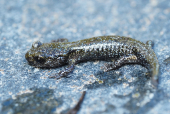Klamath Black Salamander (Aneides klamathensis)
Description: Adults measure 2 to 3 3/4 inches long from snout to vent, and up to 5.5 inches total length. A large robust plethodontid salamander with two nasolabial grooves and 14 to 16 well-defined costal grooves. Dorsal coloring is black, frosted with green or gray. The undersides are a lighter greyish black. Coloration consists of heavy frosting of greenish gray pigment overlying black ground color on the dorsal surfaces and especially on the flanks of the trunk, where there is a sharp boundary with the generally black ventral coloration. Whitish to cream-colored or faint yellow spots of small to moderate size are evident on the dorsal surfaces of the limbs but are widely scattered and few in number on other dorsal surfaces. Males have a broader head than females and especially large jaws. Young with brassy or greenish coloration and yellow at the base of the limbs.
Habitat: Occurs in mixed deciduous woodland, lowland coniferous forests, coastal grasslands. Found under rocks near streams, in talus, under damp logs, and other objects.
Range: Occurs near the north coast of California in Humboldt and Del Norte counties and east in the North Coast range in Trinity and Siskiyou counties. Also occurs just north of the California border in southwest Oregon in Jackson and Josephine counties.
Found in these States:
CA|
OR
Diet: Diet consists of a variety of small invertebrates, including millipedes, ants and termites. As salamanders grow larger, they eat fewer, but larger prey items.
Reproduction: Reproduction is terrestrial. Courtship and breeding behavior is not well known. Breeding males have a well-developed mental gland. Females probably lay from 8 to 25 eggs in moist cavities belowthe ground in July and August. Eggs are attached by peduncles. Females stay with the eggs until they hatch. Young develop completely in the egg and hatch fully formed.
Status: Listed as Least Concern in view of its wide distribution, presumed large population, and remaining suitable habitat across its range.
Taxonomy: Previously, it was considered a population of the speckled black salamander (A. flavipunctatus). However, a 2019 study found A. flavipunctatus to represent a species complex and split multiple species off it, including the Klamath population, which was described as Aneides klamathensis.
»» Kingdom: Animalia - Animals
»» Phylum: Chordata - Chordates
»» Subphylum: Vertebrata - Vertebrates
»» Class: Amphibia - (Amphibians)
»» Order: Caudata - Salamanders
»» Family: Plethodontidae - Lungless Salamanders
»» Genus: Aneides
»» Species: Aneides klamathensis - Klamath Black Salamander
This article uses material from the Wikipedia article "Klamath Black Salamander", which is released under the Creative Commons Attribution-Share-Alike License 3.0. Content may have been omitted from the original, but no content has been changed or extended.
|








